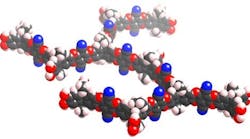Sponsored Recommendations
Sponsored Recommendations
Polymers that inefficiently fill space may efficiently store hydrogen, hope researchers in the U.K. Professors Neil McKeown of Cardiff University, Peter Budd of the University of Manchester and David Book of the University of Birmingham are developing so-called polymers of intrinsic microporosity that can hold hydrogen by physisorption and then release the gas by raising the temperature above -196°C (77K) or reducing pressure. There should be no limit to the number of store/release cycles, says McKeown, although impurities in the H2 might eventually block the micropores.
The polymer has advantages over other solids now being investigated for storing H2 (see "Hydrogen makes solid progress"), he explains.
Reversibility of hydrogen uptake and release is the major benefit for materials that work using physisorption such as these polymers. The current front-runner is probably metal hydrides but these are heavy and need to be heated to release H2. In addition, the amount of heat given off during refueling would present a massive heat exchange problem.
The porosity arises from the rigid and contorted molecular structure of the polymers so that they pack space inefficiently and leave molecular-sized gaps between the polymer chains, explains McKeown. Polymers developed so far hold around 3% H2 by weight. The porosity is only around 0.4 ml/g with a surface area of around 1,000 m2/g. We would need to double or even triple the amount of adsorbed H2 to be of practical use but we have only looked at a handful of polymers so far.
The researchers aim to synthesize polymers that have even more difficulty filling space. Also, we think that certain type of physical processing might improve the amount of microporosity, adds McKeown. We are aiming to hit 6% H2 mass loading within two years.
While its too early to peg potential cost, he notes that polymers generally can be made cheaply in bulk.
